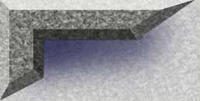Before Creating with gimp follow these instructions to get familiar with your program
The full version of this tutorial can be found at this site After installation of The GIMP 2, when you start it for the very first time, you will see something as shown
below:
Now, what you have to do first, is make the environment too suitable and comfortable for designing,
so that the usual tools and tasks can be accessed quickly and easily. For that you will have to do some initial work once.
Follow the steps:
1. First of all, there is a window showing the 'TIP OF THE DAY', I think when it should
appear when you launch the gimp. But if you wish to turn it off, just uncheck the checkbox labeled Show tip next time GIMP
stats and close the window.
2. Now, close the window on right of the screen, a new window will appear displaying you
some message, you simply click button Close all Tabs.
3. Go through menus
File > Dialogs > Create New Dock
> and click Layer, Channels & Paths
A new window will appear, in this new window note the layer tab, in layers
tab, in front of label Layers you can see a small button the left arraw, just click it and go through menus Add Tab and you
will be shown a list of tool tabs, you only select Brushes, Patterns, Gradients, Tools, Tool Options.
Then click the
Undo History Tab and click the button [X] to close it, becuase it is not that necessary at this level.
TIP : You can
change the arrangement of tabs simply by dragging their icon over other tab to bring in before the drop target. Now, if a
tab has come out of the window and became separate window while dragging, you simply drag it from its inner label and drop
it on suitable place, as shown here:
Now, go into Tab Tools, and turn all the tools ON by clicking the (EYE)
icon on left of each tool icon + name, so that all tools are available in the main gimp window (which is on left side of screen),
see image below, where I turned all tools ON:
Finally,
# Go through menus File > Preferences to
save the windows' postion. In Preferences window simply click Window Management in the list provided on left side, adn click
button Save Window Positions Now.
# Then click the Environment from left list, and follow alter enteries of right
side fields as shown here, if you have RAM greater or equal to 128 MB, and click button OK in the bottom-right corner of the
window:
REMEMBER : If you close the tabbed window on rightside, you will have to repeat the last 3 steps again,
to avoid that, always close gimp from its main window shown on left side.
Now after restarting, gimp must look like
this (on your desktop, regardless the windows' postions):
YOU ARE DONE UP TO HERE.
Now few more tips
on working with usual tools (CORE TIPS) :
# To quickly give NAME / Rename the layer, simply double click the laye
in Layers tab and enter the desired name.
# To emerge two layers quickly, bring the layers just over/below eachother,
then click the upper layer, rightclick it and press W.
# Mostaly when you emerge all layers, the layers' attributes
are discarded and it becomes nromal layer after merge. So better is to delete any flat filled background layer first and then
rightclick anywhere in layers tab and press F which will Flatten the Image.
# When you have clicked the Brush
tool make sure you have selected the appropriate brush form the Brushes tab by clicking the desired brush.
# After
working with eraser, brush, convolve, area select tool, best is you select the Move layers & selections Tool.
#
To know what the selected tool does, keep your mouse over it and it will disply you a tooltip text.
# If you have
opened more than one images, the layers tab will display the layers of only the image window in focus / on top.
#
To insert quick new layer, rightclick within the layers tab and press N.
# To quickly delete a layer, rightclick the
desired layer within the layers tab and press D.
# To copy a layer to take to other image, simply select it from layers
tab and press Ctrl+C, then go to the image where you want to insert it, and press Ctrl+V. New layer will become a Floating
Selection, to make it normal layer simply rightclick it and press N from keyboard.
# If you have created a path using
Path creation and editting tool, and then you switch to other tool the paths will be lost. To prevent this problem, immediately
after completing the path, go through menus Slect > Save to Channel, or make it selection using the path through Slect
> Select from path which automatically saves the path. Saved paths may be reused by double-clicking them from Paths tab.
# Making new brush is too easy in gimp. Select the area from your image which you wish to use as brush, then go through
menus within the image window Script-Fu > Selection > To Brush. GIMP will automatically save the selection as a new
brush of gimp itself, and select it immediately for use.
The same way, you can make custom fill patterns, by selecting
desired area and going through menus Script-Fu > Selection > To Pattern.
that's all for now, read further tutorials
for specific type of designing.
more tutorials available at GIMP TALK

